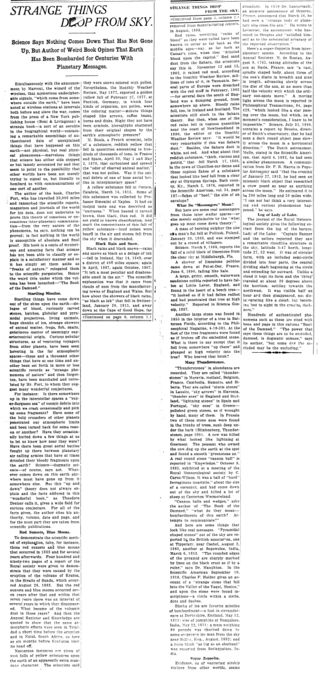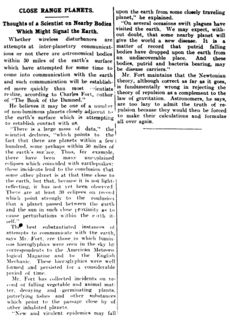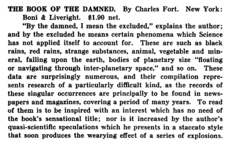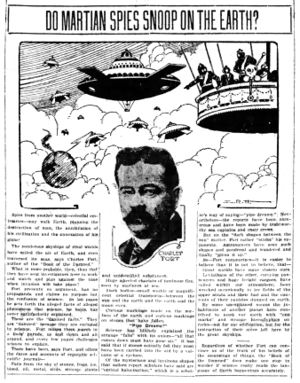The Book of the Damned (1919 book)
From Kook Science
 | |
| Author | Charles Fort |
|---|---|
| Publisher | Bon & Liveright |
| Location | New York |
| Pub. date | 1919 |
| Language | English |
| Subject | Anomalous phenomena |
| Followed by | New Lands (1923) |
The Book of the Damned is a non-fiction book by American author Charles Fort, first published in December 1919 by Boni and Liveright. It collects accounts of anomalous phenomena taken from a variety of sources by Fort, including reporting on strange falls (such as "black rains, red rains, strange substances, animal, vegetable and mineral") and inter-planetary objects, all of which constitute what Fort called "damned" data, facts he saw as disregarded in the conventional scientific accounting of the world.
Full Text
- Fort, Charles (1919), The Book of the Damned, Bon & Liveright
Advertising & Reviews
"Science Mocked. Mr. Fort's Record of Strange Happenings." - N.Y. Tribune, 17 Jan. 1920
In our view of the universe we accept the conclusions of science as unreservedly as our medieval ancestors accepted the pronouncements of the Church. True, we would not burn a man for denying the law of gravitation or insisting the earth is flat, but we would certainly set him down as crazy; and this is apt to prove quite as effective a punishment.
Now, Mr. Fort is not in the least afraid of being adjudged crazy or being subjected to any other penalty for challenging the prevalent conception of the "immutable" laws of nature. He assembles large masses of outlandish, unreasonable, impossible phenomena that have appeared in different parts of the globe and hurls them at the devoted head of dogmatic science. Mr. Fort's phenomena are absolutely damned by every canon of orthodox theory; they cannot be explained in the light of any current conception of the universe. They are a strange and motley crew, this assemblage of the damned; mysterious bodies observed in the sky by sailors at sea, unrecognized footprints discovered in the snow by Devonshire peasants, blood and stones unaccountably falling out of the air and recorded in sober scientific journals.
Out of his host of damned occurrences the author evolves an iconoclastic metaphysical system. He labels this system intermediatism. All phenomena merge imperceptibly into one another. No single fact can be proved, no single fact can be defined, no single fact can be separated from its context. All things are part of an unending chain of the universe that cannot be broken into component parts. Mr. Fort attacks conventional theories with the keen logic of an Athenian sophist. Take, for example, the following reductio ad absurdum, which he employs in analyzing Darwinism:
- "The fittest survive.
- "What is meant by the fittest?
- "Not the strongest; not the cleverest—
- "Weakness and stupidity everywhere survive.
- "There is no way of determining fitness except in that a thing does survive.
- "'Fitness,' then, is only another name for 'survival.'
- "Darwinism:
- "That survivors survive."
Merely as a record of amazing events "The Book of the Damned" makes fascinating reading. No imaginative fiction writer could conjure up stranger visions than Mr. Fort creates in his collection of mysterious happenings all over the world calculated to confuse any Horatio and his philosophy. In the Middle Ages science disposed of disturbing facts by declaring that they did not exist and showing that Aristotle had no record of them. Mr. Fort's phenomena cannot be disposed of so easily. Unless his book is smothered by a conspiracy of silence it should provoke an extremely lively series of scientific controversies.
W. H. C.
The Book of the Damned - N.Y. Times Book Review, 8 Feb. 1920
The startling title of this volume prepares the reader at the outset for something uncommon — probably bewitchingly wicked, of a nature to be read with discretion, where squeamish men and women have no chance to look over one's shoulder, and when the children have been sent safely off to bed. The opening paragraphs rather bear out that promise. Thus:
- A procession of the damned.
- By the damned, I mean the excluded.
- We shall have a procession of data that Science has excluded.
- Battalions of the accursed, captained by pallid data that I have exhumed, will march. You'll read them — or they'll march. You'll read them — or they'll march. Some of them livid and some of them fiery and some of them rotten.
- Some of them are corpses, skeletons, mummies, twitching, tottering, animated by companions that have been damned alive. There are giants that will walk by, though sound asleep. There are things that are theorems and things that are rags: They'll go by like Euclid arm in arm with the spirit of anarchy. Here and there will flit little harlots. Many are clowns. But many are of the highest respectability. Some are assassins. There are pale stenched and gaunt superstitions and mere shadows and lively malice: whims and amiabilities. The naive and the pedantic and the bizarre and the grotesque and the sincere and the insincere, the profound and puerile.
But after that, except that the jerky, Rabelaisian trick of style is maintained throughout the nearly three hundred tedious pages, it is all painfully and boresomely commonplace. What the author seems to mean — if he means anything — is that science and worldly sentiment exclude from the realm of possibility various phenomena which actually have existed. Like the farmer who, when he first saw a giraffe — or was it a rhinoceros? — declared dogmatically, "There ain't no such animal!" So the book is filled with alleged authenticated reports of red, blue, and pink snow, live frogs embedded in ice falling from the clouds, meteorites of unknown substance, flakes of snow seven inches in diameter, and so on. The assertions about these curious visitations are the excluded, or "damned," facts about which the author writes. Whether he reaches any conclusion in connection therewith, or what that conclusion is if he does reach it, is so obscured in the mass of words — a quagmire of pseudo-science and queer speculation — that the average reader will himself buried alive or insane before he reaches the end. But the queerness of the book may be its salvation. There are persons, perhaps living in Greenwich Village, who may enjoy puzzling through it.
"For Every Five People Who Read It Four Will Go Insane." - Sun & NY Herald, 15 Feb. 1920
"For Every Five People Who Read it Four Will Go Insane. Charles Fort has delighted me beyond all men who have written books in this world. Mountebank or Messiah, it matters not. Henceforth I am a Fortean. I believe." — Ben Hecht in The Chicago Daily News.
THE BOOK OF THE DAMNED
Marconi says that strange interruptions in the wireless service "may have originated outside of the earth." In this amazing book Charles Fort presents scientific facts that are startling and absorbing the thousands who are now reading his book.
The New York Tribune says:
"No imaginative fiction writer could conjure up stranger visions than Mr. Fort creates in his collection of mysterious happenings all over the world."
For sale everywhere. $1.90.
"'The Damned' Are Data Science Has Rejected" - Sun & NY Herald, 15 Feb. 1920
The sardonic prose lyricism that Charles Fort aims at in his rather astonishing and decidedly amorphous performance The Book of the Damned is entertaining for fifty pages or so — and then the reader, being quite satiated with the odd qualities of Mr. Fort's subject, gives a thought to the monotony of his methods. The reader, in fine, becomes aware that there is rather less lyricism than jaggedness. Mr. Fort writes prose that is so consciously artificial that it actually restrains the reader from admitting the author's promises and considering his arguments in due fairness.
His book, as he says, "is a procession of the damned." Lest the reader imagine that he is about to dip into a new Inferno written by another Dante, let it be explained that by "the damned" Mr. Fort means the odd bits of data that science has refused to accept in her considerations of the question whether or not there is life elsewhere and otherwise than we see it upon this earth. In his words:
- "So, by the damned I mean the excluded.
- "But by the excluded I mean that which will some day be the excluding.
- "Or everything that is, won't be.
- "And everything that isn't, will be —
- "But, of course, will be that which won't be —
So there you are! That is what the book is about.
To be more explicit. The author takes such phenomena as blood, black rains, hailstones as large as eggs, yellow matter, carved stones, all queer things falling from the skies, and offers them as objective proof of matter existing in conscious states beyond this earth.
He has dug into all sorts of research annals and out of the way minutes of scientific societies and gathered an enormous mass of apparently explicable occurrences, which he seems to accept at their face value for the very reason that most authoritative scientific organizations have either ignored or rejected them. If the reader will approach the subject in Mr. Fort's frame of mind, he will probably find much to stimulate conjecture. Mr. Fort does not set out to prove his thesis in a positive manner. He offers his facts for what they are worth, without stating explicitly what they tend to prove. And so he lets his thesis develop obliquely of itself.
Theodore Dreiser is reported to have pronounced the book "wonderful." So it is in more ways than one, but principally because of the indefatigable zeal with which the author has dredged the murky depths for his material.
"STRANGE THINGS DROP FROM SKY" - Bamberg Herald, 26 Feb. 1920
Science says Nothing Comes Down That Has Not Gone Up, But Author of Weird Book Opined That Earth Has Been Bombarded for Centuries With Planetary Messages.
Simultaneously with the announcement of Marconi, the wizard of the wireless, that mysterious undecipherable signals, "which come from somewhere outside the earth," have been noted at wireless stations at intervals both before and since the war, comes from the press of a New York publishing house (Boni & Liveright) a strange book — a sort of an aerolite in the bibliographical world — containing a remarkable assemblage of authenticated data of unexplained things that has happened on this earth — not psychical, but real physical phenomena — marvelous things that science has either side stepped or but lamely accounted for that seem to point to the possibility that other worlds have been not merely trying to signal us, but literally bombard us with communications of one sort or another.
The author of the book, Charles Fort, who has traveled 30,000 miles and ransacked the scientific reports, magazines and journals of the world for his data, does not undertake to prove his theory of conscious or unconscious communication — from inter-planetary communication — from the very nature of the phenomena, he says nothing can be proved: in fact, nothing in the world is susceptible of absolute and final proof. His book is a cento of mysterious and amazing facts that science has not been able to classify or explain in a satisfactory manner and so it has simply set them aside as "freaks of nature," relegated them to the scientific purgatories. Hence the weird title under which the volume has been launched — "The Book of the Damned."
Startling Missiles.
Startling things have come down out of the skies upon the earth — deluges of blood, curiously carved stones, stone hatchets, globular and pyramidal projectiles, living animals, huge chunks of ice, strange showers of animal matter, frogs, fish, snails, gelatinous matter of seemingly superterrestrial origin. Curious nebular structures, as of venturing voyagers from other planets, have been seen hovering in the far atmospheric spaces — these and a thousand other things that have at one time and another been set forth in more or less scientific records as "strange phenomena of nature" and then forgotten, have been marshaled and correlated by Mr. Fort, to whom they suggest many wonderful conjectures.
For instance: Is there somewhere up in the interstellar spaces a "super-Sargasso sea" of cosmic debris into which we crash occasionally and pick up some fragments? Have some of the bold crusaders of other planets penetrated our atmospheric limits and been turned back for some reason or another? Have they occasionally hurled down a few things at us to let us know how near they were? Have there been great aerial battles fought up there between planetary air sailing armies that have at times drizzled their bloody fragments upon the earth? Science, dogmatic science — of course, say not. Whatever comes down on this earth anywhere must have gone up from somewhere else. But this "up and down" theory does not always explain and the facts adduced in this "wonderful book," as Theodore Dreiser calls it, gives a wide field for curious conjecture. For all of the facts given, the author cites his authority, volume, date and page and for the most part they are taken from scientific publications.
Red Sunsets, Blue Moons.
To demonstrate the scientific method of explanation take for instance, those red sunsets and blue moons that occurred in 1883 and for several years afterwards. Four hundred and ninety two pages of a report of the Royal society were given to demonstrate that they were caused by the eruption of the volcano of Krakatoa, in the Straits of Sunda, which occurred Aug. 28, 1883. But the red sunsets and blue moons occurred seven years after that and within that seven years in which they disappeared. What became of the volcanic dust in those years? And then the Annual Register and Knowledge are quoted to show that the same atmospheric effects were seen in Trinidad a short time before the eruption and in Natal, South Africa, as long as six months before Krakatoa blew its head off.
Numerous instances are given of vast falls of yellow substances upon the earth of an apparently extra mundane character. The scientists said they were snows colored with pollen. Nevertheless the Monthly Weather Review, May, 1877, reported a golden yellow fall of February 27, 1877, at Peckloh, Germany, in which four kinds of organism, not pollen, were the coloring matter — minute things shaped like arrows, coffee beans, horns and disks. Might they not have been symbols, hieroglyphs shattered from their original shapes by the earth's atmospheric pressure?
M. Bouis, a French scientist tells of a substance, reddish yellow, that fell in quantities amounting to hundreds of thousands of tons, in France and Spain, April 30, May 1 and May 2, 1870 carbonized and spread the "odor of charred animal matter" that was not pollen. Was it the animal debris of one of those aerial battles in interplanetary space?
A yellow substance fell at Gerace, Calabria, March 14, 1813. Some of this substance was collected by Professor Simenini of Naples. It has an insipid taste and was described as "unctuous." When heated it turned brown, then black, then red. It did not yield to known classification. And mark the concomitants of this fall of yellow substance — loud noises were heard in the air and stones fell from the sky when it descended.
Black Rain and Snow.
Black rains and black snows — rains and snows as black as a deluge of ink — fell in Ireland, May 14, 1849, over a district 400 miles square; again in April, 1887, again in October, 1907. "It left a most peculiar and disagreeable smell in the air." The scientific explanation was that it came from clouds of soot from the manufacturing towns of England and Wales. But how about the "showers of black rains, as black as ink," that fell in Switzerland, January 20, 1911, and away down at the Cape of Good Hope, far removed from manufacturing centers, in August, 1888?
Red rains, terrifying "rains of blood," as they were called, have been known to occur as far back as the middle ages — nay, as far back as Caesar's time, when they "drizzled blood upon the capitol." Red sand dust from Sahara, the scientists say this is. November 12 and 13, 1902, it rained red mud, according to the Monthly Weather Review, millions of tons of it, in Tasmania. Several parts of Europe were drenched with the red stuff in February, 1903 — for several days in south of England was a dumping ground, from somewhere up above. Bloody rains fell, too, in Ireland and Scotland. The scientists still stuck to the Sahara theory. But then, when one of the red rains fell in copious quantities near the coast of Newfoundland in 1890, the editor of the Monthly Weather Review says: "It would be very remarkable if this was Sahara dust." Besides, the Sahara dust is white, not red. And what about that reddish substance, "thick, viscous and putrid," that fell March 17, 1669 in the town of Châtillon-sur-Seine, and those copious flakes of a substance that looked like beef fell from a clear sky at Olympian Springs, Bath county, Ky., March 3, 1876, reported in the Scientific American, vol. 34, page 197 — flakes of "beef" the size of an envelope?
What Do "Messengers" Mean?
But here are some real messengers from those interstellar spaces — or else merely explainable by the "what goes up must come down theory."
A mass of burning sulphur the size of a man's fist fell at Puitusk, Poland, January 30, 1868, and was stamped out by a crowd of villagers.
Science, March 9, 1888 reports the fall of a solid block of limestone from the clear sky at Middleburgh, Fla.
A shower of limestone pebbles came down at Pel-et-Der, France, June 6, 1890 falling like hale.
A large gritty smooth, waterworm sandstones cobble reported to have fallen at Little Lever, England, and found in the heart of a beech tree — "it looked as if it had fallen redhot and had penetrated that tree at high velocity." Reported in Science Gossip, 1887.
Another large stone was found in 1855 in the interior of a tree in Battersea Fields, according to the Philosophical Magazine, 4-18-381. At the foot of the tree fragments were found as if broken off the embedded stone. What is there to say except that it fell from somewhere "up there" and plunged at high velocity into the tree? Who heaved that brick?
Many Thunderstones.
"Thunderstones" in abundance are recorded. They are called "thunderstones" in Moravia, Holland, Belgium, France, Cambodia, Sumatra, and Siberia. They are called "storm stones" in Lausitz, "sky arrows" in Slavonia, "thunder axes" in England and Scotland, "lightning stones" in Spain and Portugal, "sky axes" in Greece — polished green stones, as if wrought by hand, many of them. Prussia two of these stone axes were found in the trunks of trees, sunk deep under the bark (Blinkenberg, Thunderstones, page 100). A cow was killed by what looked like lightning at Guernsey. The peasant who owned the cow dug up the earth at the spot and found a smooth "greenstone ax." A real round stone "cannon ball" is reported in "Knowledge," October 9, 1885, exhibited at a meeting of the Royal Meteorological society by C. Carus-Wilson. It was a ball of "hard" ferruginous quartzit, "about the size of a cocoanut, and had come down out of the sky and killed a lot of sheep at Casterton Wesmoreland.
"Cannon balls and wedges," asks the author of "The Book of the Damned," "what do they mean — bombardments of this earth? Attempts to communicate?"
And here are some things that look like real messages. "Pyramidal shaped stones" out of the sky are reported by the British association, one at Tipperary, near Cashel, August 2, 1865, another at Segowolee, India, March 6, 1853. "The rounded edges of the pyramid are sharply marked by lines on the black crust as if by a ruler," says Dr. Haughton. In the Scientific American September 10, 1910, Charles F. Holder gives an account of a "strange stone that fell into the Valley of the Yaqui, Mexico," and upon the stone were found inscriptions — a circle within a circle, dots and dashes.
Blocks of ice are favorite missiles of bombardment — a foot in circumference at Derbyshire, England, May 12, 1811; size of pumpkins at Bungalore, India, May 22, 1851; a mass weighing 80 pounds was chucked down by some empryean ice man from the sky near Salina, Kan., August, 1882; and a huge block "as big as an elephant" was reported from Seringpatam, India.
Super Zeppelin.
Evidence, as of venturing airship visitors from other worlds, seems abundant. In 1859 Dr. Lescarbault, an amateur astronomer of Orgeres, France, announced that March 26, he had seen a "strange body of planetary size cross the sun." He wrote to Leverrier, the astronomer, who hastened to Oregres and "satisfied himself as to the substantial accuracy of the reported observation."
Here's a super-Zeppelin from inter-planetary species. According to the Annual Register, M. de Rostan, August 9, 1762, taking altitudes of the sun at Basle, France, saw "a vast, spindle shaped body, about three of the sun's digits in breadth and nine in length, advancing slowly across the disc of the sun, at no more than half the velocity with which the ordinary sun-spots move." A moving light across the moon is reported in Philosophical Transactions, 84, page 429, "which looked like a star passing over the moon, but which, on a moment's consideration, I knew to be impossible." Science, July 31, 1896, contains a report by Brooks, director of Smith's observatory, that he had seen a dark round object pass slowly across the moon in a horizontal direction." The Dutch astronomer, Mulle, stated in the Scientific American, that April 4, 1892, he had seen a similar phenomena. A communication from Dr. F. B. Harris in Popular Astronomy said "that the evening of January 27, 1912, he had seen an intensely black object that resembled a crow posed as near as anything across the moon." He estimated it to be 200 miles long and 50 miles wide. "I can not but think a very interesting and curious phenomena happened," he says.
Log of Lady of Lake.
The journal of the Royal Meteorological society gives the following extract from the log of the barque, Lady of the Lake: "Captain Banner and the sailors reported they saw a remarkable cloudlike structure in the sky, latitude 5-47 north, longitude 27, 52 west. It was of circular form, with an included semi-circle divided into four parts, the central dividing shaft beginning at the circle and extending far outward. Unlike a cloud it kept its form and the "thing" traveled at about 20 degrees above the horizon, settling towards the northwest. It was visible half an hour and then disappeared, not disintegrating like a cloud, but becoming lost to sight in the evening darkness."
Hundreds of authenticated phenomena such as these are cited with book and page in this curious "Book of the Damned." "The power that says these things are to be excluded, damned, is dogmatic science," says its author, "but some day the excluded may be the excluding."
"CLOSE RANGE PLANETS" - Brattleboro Daily Reformer, 8 March 1920
Thoughts of a Scientist on Nearby Bodies Which Might Signal the Earth.
Whether wireless disturbances are attempts at inter-planetary communications or not there are astronomical bodies within 50 miles of the earth's surface which have attempted for some time to come into communication with the earth and such communication will be established more quickly than most scientists realize, according to Charles Fort, author of "The Book of the Damned."
He believes it may be one of a number of non-luminous planets closely adjacent to the earth's surface which is attempting to establish contact with us.
"There is a large mass of data," the scientist declares, "which points to the fact that there are planets within a few hundred, some perhaps within 50 miles of the earth's surface. Thus, for example, there have been many unexplained eclipses which coincided with earthquakes; these incidents lead to the conclusion that some other planet is at that time close to the earth, but that, because it is not light-reflecting, it has not yet been observed. There are at least 30 eclipses on record which point strongly to the conclusion that a planet passed between the earth and the sun in such close proximity as to cause perturbations within the earth itself."
The best substantiated instances of attempts to communicate with the earth, says Mr. Fort, are those in which luminous hieroglyphics were seen in the sky by correspondents to the American Meteorological Magazine and to the English Mechanic. These hieroglyphics were well formed and persisted for a considerable period of time.
Mr. Fort has collected incidents on record of falling vegetable and animal matter, decaying and germinating plants, putrefying fishes and other substances which point to the passage close by of other inhabited planets.
"New and virulent epidemics may fall upon the earth from some closely traveling planet," he explained.
"On several occasions swift plagues have visited the earth. We may expect, without doubt, that some nearby planet will give the world a new disease. It is a matter of record that putrid falling bodies have dropped upon the earth from an undiscoverable place. And these bodies, putrid and bacteria bearing, may be disease carriers."
Mr. Fort maintains that the Newtonian theory, although correct as far as it goes, is fundamentally wrong in rejecting the theory of repulsion as a complement to the law of gravitation. Astronomers, he says, are too lazy to admit the truth of repulsion because they would then be forced to make their calculations and formulae all over again.
The Book of the Damned - Catholic World, June 1920
"By the damned, I mean the excluded," explained the author; and by the excluded he means certain phenomena which Science has not applied itself to account for. These are such as black rains, red rains, strange substances, animal, vegetable and mineral, falling upon the earth, bodies of planetary size "floating or navigating through inter-planetary space," and so on. These data are surprisingly numerous, and their compilation represents research of a particular difficult kind, as the records of these singular occurrences are principally to be found in newspapers and magazines, covering a period of many years. To read of them is to be inspired with an interest which has no need of the book's sensational title; nor is it increased by the author's quasi-scientific speculations in which he presents in a staccato style that soon produces the wearying effect of a series of explosions.
"DO MARTIAN SPIES SNOOP ON THE EARTH?" - Arizona Daily Star, 30 July 1920
Spies from another world — celestial emissaries — may walk Earth, planning the destruction of man, the annihilation of his civilization and the annexation of his globe!
The ponderous skyships of rival worlds have sailed the air of Earth, and even traversed its seas, says Charles Fort, author of the "Book of the Damned."
What is more probable, then, than that they have sent investigators here to work and watch and plan against the time when invasion will take place?
Fort presents no argument, has no propaganda and claims no purpose but the confusion of science. In 500 pages he sets forth the alleged facts of alleged phenomena that science, he holds, has never satisfactorily explained.
These are the "damned facts." They are "damned" because they are excluded by science. Fort makes them march in a fools' parade, up and down and all around, and every few pages challenges science to explain.
There have been, says Fort, and offers the dates and accounts of reputable scientific journals —
Falls from the sky of stones, frogs, ice, blood, oil, metal, birds, strange plants and unidentified substances.
Huge wheeled chariots of luminous fire, seen by mariners at sea.
Dark bodies — small worlds or magnificent celestial transports — between the sun and the earth and the earth and the moon even.
Curious markings made on the surface of the earth and curious markings on stones that have fallen.
"Pipe Dreams?"
Science has blithely explained the strange "falls" with its axiom — "all that comes down must have gone up." It has said that if stones actually they must have been carried into the aid by a volcano or a cyclone.
Of the mysterious and luminous shapes that sailors report scholars have said are "optical hallucination," which is a scholar's way of saying — "pipe dreams." Nevertheless — the reports have been numerous and have been made by trustworthy sea captains and their crews.
But on the "dark shapes between the sun" matter, Fort rather "sticks" his opponents. Astronomers have seen such shapes and pondered and wondered and finally "given it up."
So — Fort summarizes — it is easier to believe than it is not to believe, that —
- Great worlds have come close to ours.
Leviathans of the ether, carrying passengers and huge freight cargoes, have sailed within our atmosphere; been wrecked occasionally in ice fields of the upper strata and their fuel and contents of their pantries dumped on earth.
By some unexplained means the inhabitants of another planet have contrived to mark our earth with "cup marks" and strange hieroglyphics on rocks — not for our edification, but for the instruction of their spies left here by the great skyships.
Regards of whether Fort can convince us of the truth of his beliefs of the meanings of things, the "Book of the Damned" does make one stop to wonder if science really reads the language of Earth happenings accurately.
"Insult and Research" - Fort responds to NYPL's "OAZ" Classification, 24 Oct. 1920
The New York Public Library has branded "The Book of the Damned" with big, white letters, "O A Z". All books with this class-mark are catalogued under "Eccentric Literature." I have assembled, in this book, hundreds of accounts of astonishing objects and substances that have fallen from the sky, or from vast, dirigible constructions that have been seen close to this earth. Even with all its heresies, "Popular Astronomy" and other scientific publications have reviewed the book respectfully. It represents enormous labor. In my opinion this action by the library is not good for independent research in the United States.
CHARLES FORT.








